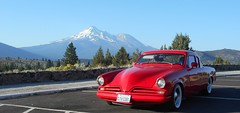I normally recommend the Carter P4389 type rotory pump. I've installed a few on my own cars over the years, put them on friends cars and recommended them to people that have also used them. While not any of these were "race" type engines, many are/were more thAn stock hp. street engines (350hp range), all street drivers.
One thing I've found, is that despite the "listed" pressures being in the 7 to 9psi range, I've always found them to put out more thAn that and always require a regulator to keep the carburetor fuel level properly regulated.
My 259 powered Lark's fuel pump finally decided it wanted to go to where ever it is that all mechanical parts go when they are dead..
I was originally going to use one of those little square pumps like Studebaker Int. sells, but the 1/8" NPT fittings only have about a 3/16" dia. hole in them. Bout the same size as your brake lines...Na...too small. While you may have a good "pressure", you surely won't have good volume for spirited...driving.
So I decided to try one of Carters (yea, Carter/Fedral Mogal again) "inline" pumps. It's a model P60504, simillar to the FI type pumps. While it only puts out about 4psi, that should be plenty to sustain 250hp on any US freeway. And what normal Stude engine will produce all of that much power for any length of time...!?
The inlet and outlet is 5/16" so it's an easy swap to the OEM fuel line and should provide plenty of volume. It also comes with a steel canister filter attached. The only questionable thing I noticed is that both line connections are plastic..!? So the Stude lines should be bent to match the pumps "in and outlets" pretty close to keep any load off the plastic.
I attached it to the frame, just ahead of the front spring/body mount with the "P" clamp that comes with it, and fastened it to the frame...with no special sound deadening goodies.
I cut the line and stuck it in. I drilled a hole in the frame flange and rather than use just the "thread-in" fastener, I used a nut and bolt arrangement, along with two pieces of fuel injector capible 5/16" rubber fuel line. I used a squirt bottle to fill the filter with fuel so as to not have the pump run dry as soon as the switch is hit.
I also made a new fuel line from the stock fuel line outlet at the frame, up to the carburetor (three bends and a 3" piece of rubber hose). It's "NEVER" a good idea to run pressure thru a stock pump. The diaphram splits......and you have fuel in the crank case...!
While you can hear the pump run with the engine off, it's sound is deadened quickly by the sound of the engine (stock engine, dual exhaust). Even standing next to the pump, with the engine running, it can't be heard.
I ran it around our freeway circle (bout 19 miles), with a couple of fairly steep climbs. Ran it to an honest 80mph going up one of the steeper hills.....no problem.
Just thought I'd throw this out there to people that want an easy to install, "sorta" cheap fuel pump assembly, that they don't have to screw with "other" parts. A very easy to assemble, fairly quiet fuel pump.
No clue as to how long it will last...!
Mike
One thing I've found, is that despite the "listed" pressures being in the 7 to 9psi range, I've always found them to put out more thAn that and always require a regulator to keep the carburetor fuel level properly regulated.
My 259 powered Lark's fuel pump finally decided it wanted to go to where ever it is that all mechanical parts go when they are dead..
I was originally going to use one of those little square pumps like Studebaker Int. sells, but the 1/8" NPT fittings only have about a 3/16" dia. hole in them. Bout the same size as your brake lines...Na...too small. While you may have a good "pressure", you surely won't have good volume for spirited...driving.
So I decided to try one of Carters (yea, Carter/Fedral Mogal again) "inline" pumps. It's a model P60504, simillar to the FI type pumps. While it only puts out about 4psi, that should be plenty to sustain 250hp on any US freeway. And what normal Stude engine will produce all of that much power for any length of time...!?
The inlet and outlet is 5/16" so it's an easy swap to the OEM fuel line and should provide plenty of volume. It also comes with a steel canister filter attached. The only questionable thing I noticed is that both line connections are plastic..!? So the Stude lines should be bent to match the pumps "in and outlets" pretty close to keep any load off the plastic.
I attached it to the frame, just ahead of the front spring/body mount with the "P" clamp that comes with it, and fastened it to the frame...with no special sound deadening goodies.
I cut the line and stuck it in. I drilled a hole in the frame flange and rather than use just the "thread-in" fastener, I used a nut and bolt arrangement, along with two pieces of fuel injector capible 5/16" rubber fuel line. I used a squirt bottle to fill the filter with fuel so as to not have the pump run dry as soon as the switch is hit.
I also made a new fuel line from the stock fuel line outlet at the frame, up to the carburetor (three bends and a 3" piece of rubber hose). It's "NEVER" a good idea to run pressure thru a stock pump. The diaphram splits......and you have fuel in the crank case...!
While you can hear the pump run with the engine off, it's sound is deadened quickly by the sound of the engine (stock engine, dual exhaust). Even standing next to the pump, with the engine running, it can't be heard.
I ran it around our freeway circle (bout 19 miles), with a couple of fairly steep climbs. Ran it to an honest 80mph going up one of the steeper hills.....no problem.
Just thought I'd throw this out there to people that want an easy to install, "sorta" cheap fuel pump assembly, that they don't have to screw with "other" parts. A very easy to assemble, fairly quiet fuel pump.
No clue as to how long it will last...!
Mike



Comment